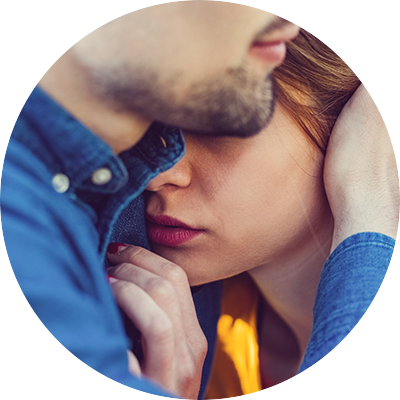PANIC DISORDER
Panic disorder is a form of anxiety disorder. While other anxiety disorders have strong emotional and psychological components, panic disorder is known mainly for its physical symptoms, namely the panic attack. The symptoms of a panic attack can be terrifying for those who experience them. While in alcohol and drug rehab at Bluff, our team of psychiatric providers, nurses and therapists will help individuals find effective ways of treating panic disorder and managing the symptoms of panic attacks.
Panic Attack Symptoms
According to the National Institute of Mental Health, panic disorder is characterized by unexpected and repeated episodes of intense fear accompanied by physical symptoms that may include chest pain, heart palpitations, shortness of breath, dizziness, or abdominal distress. These episodes occur suddenly, without an apparent cause for the fear or stress. People may be diagnosed with panic disorder after experiencing recurrent panic attack symptoms, and if worries about having another panic attack interferes with their life in significant ways.
Panic attack symptoms can strike at any time – while at work, driving, in class or even sleeping. Panic attacks may occur occasionally, or frequently, and the frequency and severity of panic attacks vary widely between individuals. Signs and symptoms of a panic attack include:
- Rapid or pounding heartbeat.
- Shaking or trembling.
- Chest pain or feeling short of breath, which may be mistaken for a heart attack.
- Numbness, tingling, jitteriness.
- Chills or profuse sweating.
- Feeling lightheaded, dizzy, as if you’re about to pass out or faint.
- Hyperventilating.
- Flushed skin.
- Feeling like you’re choking.
- Stomach pain or nausea.
- Fearing you’re about to lose control or die.
How to Tell the Difference Between a Panic Attack
and a Heart Attack?
It’s not always easy to tell the difference between a panic attack and a heart attack since the symptoms can overlap. Even doctors can’t always immediately tell the two conditions apart. In a cruel twist, those who have panic disorder often have anxiety related to their health. They may be more likely to assume their chest pain is caused by a heart attack, which in turn ratchets up their anxiety levels even higher.
When in doubt about chest pain, call 911. If it turns out to be a panic attack and not a heart attack, rest assured you will not be the first person to be seen in an emergency department due to a panic attack that was mistaken for a heart attack.
There are some important indicators to look out for that help differentiate between a panic attack and a heart attack.
Chest pain due to heart attack typically escalates quickly, and is associated with pain, pressure or an ache in the chest. The pain often radiates to other areas, such as the arms (especially the left side), stomach, back, shoulders, neck, throat or jaw. Pain may worsen with exertion and be accompanied by shortness of breath. People having a heart attack may also feel nauseous and vomit.
Signs of a panic attack include a rapid heart rate and a sharp or stabbing pain in one area of the chest. The pain typically subsides after a few minutes. Unlike a heart attack, the pain may either get better or worse when you change positions, and doesn’t typically radiate to other parts of the body. Vomiting can also be a result of a panic attack, however vomiting is less common when experiencing a panic attack than a heart attack.
People also typically do not lose consciousness during a panic attack, which may occur during a heart attack. Panic attacks typically last only 30 minutes or less. Afterward, the individual may feel fatigued, but other than that is fine.
Another indication that the chest discomfort is due to a panic attack rather than a heart attack may be the age of the individual. Men and women tend to start experiencing panic attacks in their 20s, although some people may have their first panic attack in their teens while others not until their 30s. It is uncommon, though not unheard of, for people to have heart attacks in their 20s and 30s. Those who have heart attacks when they’re young usually have a previously diagnosed heart condition. The risk of heart attack is much higher in someone in their 50s, 60s and older.
Panic attacks are unpleasant but they do not cause long-term damage to physical health. People recover from panic attacks and they may never have another one. The same cannot be said for heart attacks. If you’re experiencing chest pain and you’re not sure of the cause, seek medical attention immediately. Getting treatment for a heart attack quickly can minimize damage to the heart muscle and potentially save your life.
Prevalence of Panic Disorder
An estimated 2.7% of U.S. adults had panic disorder in the past year, according to the National Institute of Mental Health. Women are somewhat more likely than men to have panic disorder (3.8% compared to 1.6%). Nearly 5% of U.S. adults will experience panic disorder at some time in their lives.
Panic disorder may be mild, moderate or serious. The level of panic disorder is determined by the frequency of panic attacks, the severity of the episodes, how much panic disorder interferes with a person’s life, and other factors. For example, fear of having a panic attack may cause people to avoid situations where they had a panic attack. Intense worry about having another attack (known as panic-focused anticipatory anxiety), or fear of having a panic attack that results in not going to work or socializing with friends, is a major reason panic disorder can be so debilitating.

Risks Associated with Panic Disorder
Although the physical effects of a panic attack resolve quickly, panic attacks can impact people’s psychological and emotional health. People who have panic attacks are already anxious. Worrying that they may suddenly feel like they can’t breathe, are choking, or are about to lose control can cause debilitating side effects that ripple through their lives.
Panic attacks become debilitating when people experience them frequently. Some individuals suffer from weekly and even daily panic attacks. This may lead people to stop going to work, become socially isolated, and avoid leaving the house. Panic disorder is associated with a specific phobia known as agoraphobia.
Even if panic attacks occur infrequently, people may also live in fear of experiencing another terrifying panic attack. Worrying about panic attacks causes significant emotional distress and anxiety. Panic disorders are also associated with a higher risk of phobias, such as fear of driving or leaving the home, as well as suicide and suicidal thoughts.
Agoraphobia
Agoraphobia is a disorder in which a person experiences anxiety in certain situations, and begins to avoid situations associated with those fear. Fears are often centered around being unable to escape or experiencing a panic attack in public, and facing public embarrassment. Individuals with agoraphobia become reluctant to leave what they consider their personal safety zone. In severe cases, an agoraphobic may confine themselves to their home for years on end. They may welcome visitors or work from home successfully, but they feel they cannot leave their comfort zone. Symptoms of agoraphobia include fears of:
- Using public transportation
- Standing in line or behind a crowd
- Being in open spaces
- Being outside of the home alone
- Being in enclosed spaces
About one of every three people with panic disorder develops agoraphobia.

How to Stop a Panic Attack
One of the ways to cope with panic attacks is to recognize when one is coming on. By knowing the signs, you may be able to take steps to calm yourself, and avoid having a full-blown panic attack. Also, by recognizing you’re having a panic attack, you can remind yourself that you’re not having a heart attack, that something terrible isn’t about to happen, and that this frightening feeling will pass. Specific tips for coping with a panic attack include:
Deep breathing: Focus on taking long, slow breaths. Breathe in deeply through your nose and allow yourself to exhale gradually. Try counting to four when you breathe in and again when you breathe out. Feel the rise and fall of your chest and turn your thoughts to the simple act of breathing.
Close your eyes: Closing your eyes can make it easier to focus on your breathing, to stay in the moment and to shut out any stimuli in your environment that may be triggering the panic attack. For example, if you’re in a crowded elevator and the feeling of being enclosed is causing anxiety, shut out those images.
Practice mindfulness: Mindfulness is a deliberate effort to be in the moment. A relaxation technique, mindfulness brings people’s awareness into the present, and can be a way of calming feelings of fear or anxiety before those emotions become overwhelming. For example, if a particular fear or anxiety comes to the front of your mind and you start feeling the signs of a panic attack rising, ask yourself: Are you OK at that moment, and are these thoughts actually true or simply a fear or worry?
Get moving: Exercise lifts the mood, and can distract you from whatever you’re worried about. Exercise has been shown to be an effective treatment for anxiety disorders, including panic disorder. If you feel your anxiety levels rising, go for a brisk walk, a light jog or anything to get you up and moving. It may help control any anxiousness and fears that can precipitate panic attacks, as well as alleviate depression.
What Causes Panic Attacks?
Although the exact causes of panic attacks and panic disorder are unknown, environmental (such as stressful life experiences), genetic and biological factors are believed to be involved.
People who have been subjected to trauma, such as childhood physical or emotional abuse, are at higher risk of panic disorder. People with post-traumatic stress disorder (PTSD) have high rates of panic disorder. Severe stress, such as the death of a close family member, divorce, or job loss can trigger panic attacks.
Panic disorder tends to run in families, suggesting a genetic predisposition. Researchers have found a link with certain physical illnesses, including heart disease, diabetes, thyroid problems, lung diseases such as asthma or COPD, and the onset of panic disorder. It’s also been noted that many people report their first panic attack after a physical illness.
Many people with panic disorder have co-occurring conditions such as depression. Some also use drugs and alcohol to cope with panic disorder. Substance use makes panic disorder worse.

PANIC DISORDER AND SUBSTANCE ABUSE
Research has linked alcohol and drug use with panic disorder. Some people use alcohol or drugs to self-medicate anxiety or panic disorders.
But alcohol and drugs can also cause panic attacks.
People who have an alcohol use disorder are two to three times more likely to have an anxiety disorder, including panic disorder, than the general population, according to a study in Alcohol Research Current Reviews.
The link is particularly strong between panic disorder and alcohol use in women. Studies have found that women with anxiety disorders such as panic disorders tend to start drinking at an earlier age, have alcoholism that progresses faster, and experience symptoms of alcohol withdrawal more often than women with an alcohol use disorder but without an anxiety disorder.
A diagnosis of panic disorder is also a risk factor for a relapse among people with a substance use disorder. In women in particular, panic disorder is associated with social phobia. Social phobia has been shown to be a barrier to women in seeking treatment or participating in 12-step groups.
Does One Panic Attack Mean You’ll Have Another?
Not necessarily. Many people have just one or two panic attacks in their lifetimes, after which they never have another. Panic attacks often occur during periods of stress or change in life. After the stress dissipates, the panic attacks may disappear with it.
Panic disorder can continue for months or years. Some people may experience several months or years of frequent symptoms, then many symptom-free years. There is some evidence that many people may naturally experience a partial or even complete reduction in symptoms after middle age.

Treatment for Panic Attacks
If you’re experiencing panic attacks that are interfering with your ability to relax, enjoy your social life or work, it’s important to seek treatment. Bluff’s team of experienced professionals, psychiatric providers and therapists has the expertise to treat addiction along with co-occurring panic disorder. Alleviating panic disorder is crucial to helping patients achieve the peace of mind that they need to remain drug and alcohol free. Treatments for panic disorder offered at Bluff’s Augusta, Georgia residential addiction rehab center include:
Psychotherapy
Psychotherapy, also called talk therapy, helps individuals understand panic attacks and panic disorder while learning strategies to cope with a panic attack should one occur. Through cognitive behavioral therapy (CBT), individuals learn to recognize panic attack symptoms for what they are – frightening, but not actually dangerous. While a person may feel like they are having a heart attack, in reality they’re not. Recognizing this can help people learn to worry less that they will experience another panic attack. And if they do, knowing that they are actually OK can make the symptoms less terrifying. In CBT, individuals also work toward overcoming fears of situations that they may have avoided in the past because of anxiety about having a panic attack in public.
Medications
Medications can help reduce symptoms of panic attacks. Physicians may prescribe selective serotonin reuptake inhibitors (SSRIs), a type of antidepressant. Examples include fluoxetine (Prozac), paroxetine (Paxil, Pexeva) and sertraline (Zoloft).
Another type of antidepressant medication used to treat panic attacks are serotonin and norepinephrine reuptake inhibitors (SNRIs), such as venlafaxine (Effexor XR).
Benzodiazepines, such as alprazolam (Xanax) and clonazepam (Klonopin), are used to treat panic disorder but are not good choices for people who have problems with drug and alcohol use because of the potential for misuse. Benzodiazepines can be addictive, and withdrawing from benzodiazepines can lead to anxiety and panic attacks. That is a cycle people struggling with addiction and panic attacks need to avoid.
REQUEST A CONFIDENTIAL EVALUATION
"*" indicates required fields

